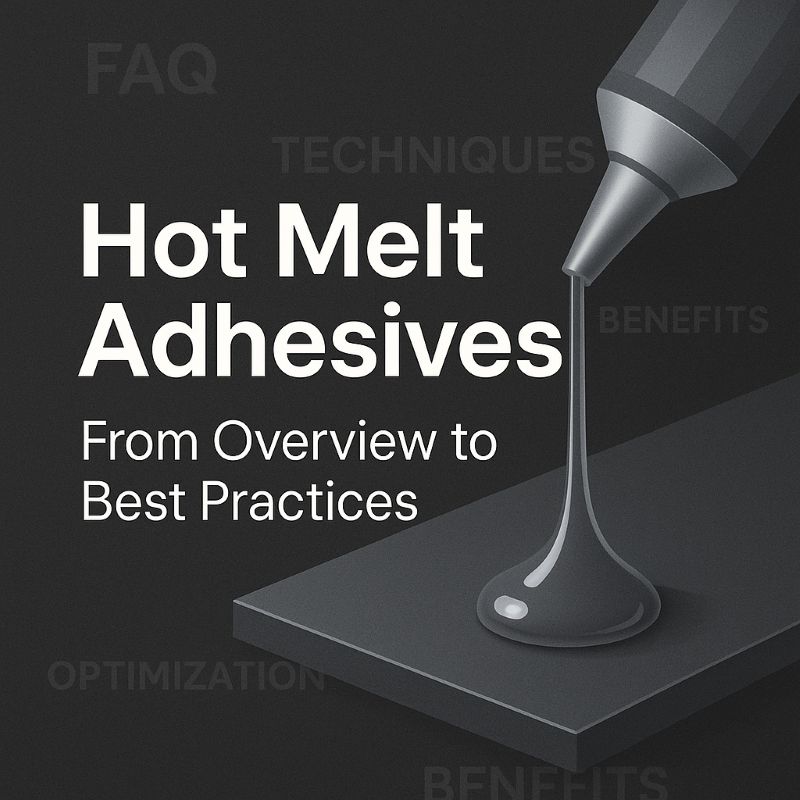
Hot Melt Adhesives Overview
Adhesive Types and Uses
Manufacturing Benefits
Application Techniques
Process Optimization
Innovations in Adhesives
Implementation Best Practices
Frequently Asked Questions (FAQ)
Hot melt adhesives are transforming manufacturing by offering fast-setting performance, clean application, and versatility across substrates. These thermoplastic adhesives are applied in molten form and quickly solidify, enabling rapid bonding without the need for drying or curing. Advanced hot melt formulations are now optimized for high-speed automation, precise application, and minimal residue, making them ideal for sectors like electronics, packaging, and consumer goods assembly.
Hot melt adhesives are available in a range of formulations to support specific applications:
General-purpose adhesives are commonly used in packaging and labeling for their fast bonding speed.
High-strength variants offer superior durability for assembly of complex components.
Substrate-compatible types are designed for paper, plastics, metals, and composites.
Low-viscosity grades excel in automated dispensing systems due to their smooth flow and clean finish.
Heat-sensitive formulations support precision bonding in woodworking and soft materials.
These types support increased production efficiency across sectors like automotive interiors, small appliance manufacturing, and high-speed logistics.
Hot melt adhesives deliver multiple benefits to modern manufacturing environments:
Fast setting times improve production throughput
No drying or curing needed leads to reduced cycle times
Strong and flexible bonding supports mechanical and environmental demands
Clean application reduces material waste and improves product appearance
Automated compatibility allows seamless integration into modern lines
These characteristics make hot melt adhesives valuable tools for lean, cost-effective, and high-speed production.
Successful implementation of hot melt adhesives requires appropriate application methods:
Automated spray or slot-die systems for high-speed operations
Precision hot melt guns for controlled manual bonding
Roll coating for large surface coverage in woodworking or textile finishing
Nozzle systems optimized for low stringing and exact pattern control
Proper equipment selection and maintenance help maintain bonding consistency and reduce defects.
To optimize production lines using hot melt adhesives, consider:
Minimizing cycle time with fast-setting adhesives
Selecting low-viscosity grades for smoother dispensing
Ensuring material compatibility for consistent bonding strength
Reducing thermal degradation through stable temperature control
Streamlining changeovers by using clean, low-residue adhesives
These tactics help manufacturers scale efficiently while ensuring repeatable product quality.
Recent innovations in hot melt adhesive technology include:
Eco-friendly formulations with low VOC emissions and reduced carbon footprint
Smart adhesive systems compatible with Industry 4.0 and sensor feedback
Low-energy bonding requiring less heat for activation
Advanced thermoplastic resins that improve bonding strength and longevity
Precision-engineered flow characteristics for automated, high-speed systems
These advancements enhance manufacturing flexibility while aligning with sustainability targets.
To successfully implement hot melt adhesives in production:
Assess bonding needs based on substrate, speed, and performance requirements
Select appropriate adhesive formulations optimized for automation and clean finish
Use quality dispensing equipment such as automated nozzles or hot melt applicators
Train operators to ensure correct handling, temperature control, and maintenance
Track performance data to refine settings and maximize efficiency
Continuously test and validate to ensure reliable long-term results
Following these practices ensures smoother adoption and better operational outcomes.
What are hot melt adhesives?
They are thermoplastics applied in a molten state that solidify upon cooling, creating strong, flexible bonds.
What are the benefits of using hot melt adhesives in manufacturing?
They offer fast bonding, reduced cycle time, clean application, and strong adhesion across various materials.
Which industries use hot melt adhesives?
Packaging, electronics, woodworking, labeling, and appliance assembly are some of the most common.
How do I choose the right hot melt adhesive?
Consider material compatibility, environmental conditions, production speed, and bond strength requirements.
What application techniques work best?
Automated nozzles, slot-die systems, and hot melt guns can be used depending on the process and product.
How do hot melt adhesives optimize production?
They eliminate curing delays, minimize waste, and support high-speed line operations.
What best practices should be followed during implementation?
Match adhesives to process needs, use the right tools, train staff, and evaluate performance regularly.